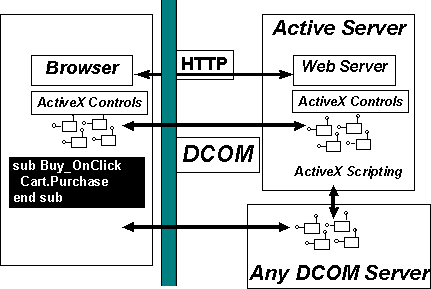
Besides just using the Internet as a cheap TCP/IP network, distributed applications can also take advantage of existing standard protocols and formats wherever that makes sense. For noninteractive, textual, or simple graphical information, HTML pages are a great vehicle that provide a well-known and easy way for users to access the information they require.
For more complex, structured, and interactive information, custom components can extend the HTML page to perform the real tasks of the distributed applications in a user-friendly, secure, and efficient manner. Simple business rules can be applied on the client side, providing immediate feedback to the user. More complex business rules can transparently involve server components over DCOM. Thanks to DCOM's language neutrality, these components can be implemented in virtually any programming language, including C++, Java, Visual Basic, or Cobol. Existing off-the-shelf components (ActiveX controls) can be tied to client-side or even server-side custom components using Visual Basic Script or JScript. Please refer to Most of the papers referenced in this whitepaper are available on the Technology Preview CD. URLs to documents which are available for download are listed below.
[DCOM - Architecture] and [ActiveX] for more details.

Regardless of whether the developer enriches a distributed application with HTML elements or enriches a HTML-based "application" with elements of distributed computing, DCOM provides the necessary component glue to tie the different worlds together.